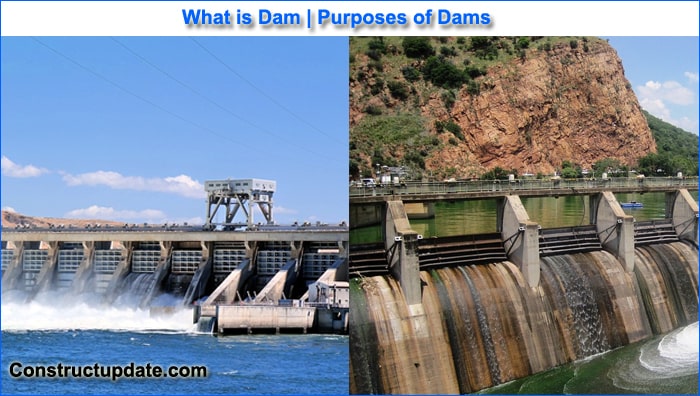What is Dam | 6 Main Purposes of Dams | Uses of Dams | Dam Site Selection
What is a Dam?
A dam is a building constructed on a river, stream, or estuary to store water. It immediately contributes to ensuring that there is enough water available for agriculture, industry, and human use. Concrete dams and embankments are the two main categories of modern dams. Streams that flow through small gorges are blocked by concrete or masonry dams, but rivers and streams that flow through large valleys are controlled by embankments.
Nagarjuna Sagar Dam in Andhra Pradesh is an illustration of a masonry dam in India. The Tehri Dam in Uttarakhand is an instance of an embankment dam in India. In India, a sizable portion of the population has a water crisis or poor management of water resources. To start, many areas of the nation lack access to enough clean water for irrigation or consumption.
Flash floods, on the other hand, are a common occurrence in many areas. Man-made structures like dams and reservoirs have been built across streams and rivers as a solution to this ongoing issue. The article examines the functions, primary benefits, and drawbacks of dams.

Uses of Dams
Now that we have a fundamental idea of what a dam is, let’s look at some of its applications. It is regarded as a valuable water resource. They supply water for a range of uses, such as domestic use, irrigation, and commercial applications.
Dams are also used to facilitate river transportation and generate energy. The use of dams is becoming more and more prevalent in daily life. Additionally, dams encourage regional tourism, aiding in the development of the country.
Dams have a variety of applications. Here are some of the more typical ones:
- Reservoir water serves residential, commercial, and mining regions with freshwater.
- Water that is preserved is used for irrigation.
- Helps make it easier to produce electricity from renewable sources, including hydropower.
- Helps to control the water flow of rivers and streams and safeguards the villages that are Located in the valley below.
- Helps with water conservation so that future needs can be met.
Now that we know that, let’s find out the connected benefits and drawbacks of dams.
Site selection of dam
A dam is a substantial building that costs a lot of money. When choosing the dam’s location, much attention must be given. Making the wrong choice could result in exorbitant costs and construction and maintenance problems. When choosing a dam’s location, the following variables are considered.
Topography:
Where the river has a tight canyon that opens up upstream to create a large reservoir, a dam should ideally be placed there.
Suitable foundation:
A specific kind of dam should be able to be built there if the foundation is present.
Good site for reservoir:
Since the dam is built to store water in a reservoir, a suitable reservoir location should have the following qualities.
Large storage capacity:
The site’s topography allows for a substantial amount of water storage in the reservoir.
The shape of the reservoir basin:
Preferably, the reservoir basin upstream of the dam should have a cup-like form, a flat bottom, and steep slopes.
Water tightness of reservoir:
The reservoir site’s geology ought to be such that the reservoir basin is waterproof.
Good hydrological condition:
The hydrological state of the reservoir should be such that there is enough runoff at the reservoir site.
Deep reservoir:
After the dam is built, the location should allow for the formation of a substantial reservoir.
Small submerged area:
The location should be chosen so that there is minimal submerged area. A valuable piece of land and property should be submerged.
Low silt inflow:
The location of the dam must prevent the reservoir from rapidly silting up.
Spillway site:
A good location for a spillway should be present at or close to the dam site depending on how the dam is built.
Availability of materials:
For the dam to be built, a lot of materials are needed. To cut costs, suitable materials should be present on-site or nearby the dam in adequate quantities.
Accessibility:
The site must be simple to find.
Minimum overall cost:
The location should be chosen such that the project’s entire cost, including ongoing maintenance, is as low as possible.
Healthy surrounding:
For workers to live in colonies built close to the dam site safely, the area around the site must be safe and mosquito-free.
6 Main Purposes of Dams
1. Water Storage
This might be considered one of the main purposes for dams and reservoirs. Reservoir water helps to compensate for water shortages during dry seasons. Additionally, it guarantees a steady supply of water for domestic, commercial, and agricultural use.
2. Flood Control
Without a doubt, one of the main purposes of dams is to reduce flooding. Dams aid in flood control by redirecting floodwater toward other purposes, holding excess water, or carefully releasing it. In turn, it aids in preventing deaths and subsequent displacement.
3. Irrigation
The function that dams serve in irrigation is one of its most important advantages. Dams have made it much easier for farmers to deal with the issue of watering crops, which has increased crop productivity.
4. Electricity Production
In many Indian districts, hydropower has become an efficient solution to the country’s ongoing energy crisis. Additionally, hydropower is a clean source of energy and does not produce any pollutants. Some of India’s top hydropower facilities include the Tehri, Srisailam, and Sardar Sarovar dams.
5. Debris Control
Dams are frequently effective at containing harmful sedimentation in addition to reducing floods. In reality, they might be useful in avoiding the disposal of hazardous materials and ensuing contamination.
6. Recreation
Dams offer leisure opportunities for people, which is one of their advantages. In the still water, one can go boating, skiing, and fishing. Tourists frequently visit Maithon Dam and Bhakra Nangal Dam as destinations for outdoor enjoyment.
Disadvantages of Dams
Despite the wide range of advantages they offer, dams also have a sizable number of drawbacks. A quick description is provided below.
- Eviction of residents during construction.
- High levels of greenhouse gases are frequently released by reservoirs.
- Regularly disturbs regional ecosystems.
- The groundwater table is disturbed.
- Prevents the flow of water to other nations, states, or areas.





